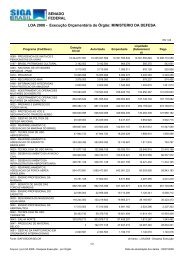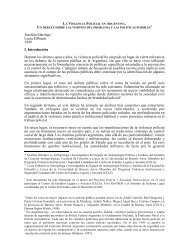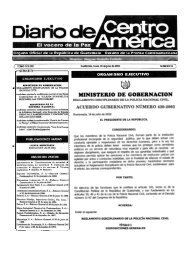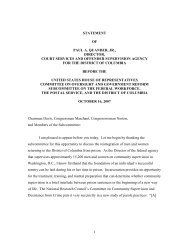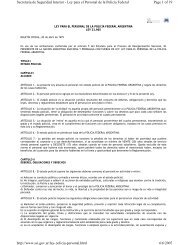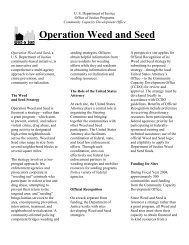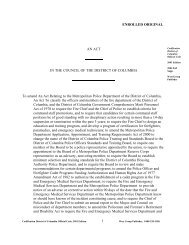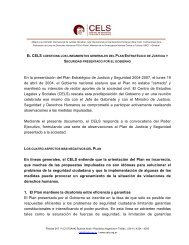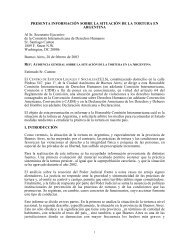Venezuela: The Life and Times of the Party System - Political ...
Venezuela: The Life and Times of the Party System - Political ...
Venezuela: The Life and Times of the Party System - Political ...
Create successful ePaper yourself
Turn your PDF publications into a flip-book with our unique Google optimized e-Paper software.
Angarita. Seeking a base <strong>of</strong> support independent from Lopez, <strong>and</strong> perhaps influenced by <strong>the</strong><br />
climate <strong>of</strong> democratic struggle in World War II, Medina began a gradual liberalization, making<br />
union <strong>and</strong> political organization much easier. With <strong>the</strong>se changes in <strong>the</strong> air, an amalgam <strong>of</strong><br />
groups applied for legal status, <strong>and</strong> Acción Democrática achieved it in September 1941.<br />
<strong>The</strong> leaders <strong>and</strong> activists <strong>of</strong> Acción Democrática (AD) immediately set out to build a kind<br />
<strong>of</strong> political structure hi<strong>the</strong>rto unknown in <strong>Venezuela</strong>: a party that was permanent, present at all<br />
levels <strong>of</strong> national <strong>and</strong> local life, <strong>and</strong> capable <strong>of</strong> integrating many interests <strong>and</strong> groups in its<br />
organized life. 1 From <strong>the</strong> beginning, <strong>the</strong> party was vertically integrated, with powerful links<br />
binding block <strong>and</strong> neighborhood to regional <strong>and</strong> national structures. This was something utterly<br />
new in <strong>Venezuela</strong>, especially in <strong>the</strong> geographically <strong>and</strong> socially marginal communities where AD<br />
concentrated its early efforts. Links to <strong>the</strong> party provided welcome sources <strong>of</strong> orientation,<br />
legitimation, <strong>and</strong> solidarity, as well as avenues for redress <strong>of</strong> grievances <strong>and</strong> mobility. <strong>Party</strong><br />
activists were also present at <strong>the</strong> creation <strong>of</strong> organized civil society, including trade unions,<br />
peasant groups, teachers’ organizations, student <strong>and</strong> pr<strong>of</strong>essional societies. <strong>The</strong>ir efforts meant<br />
that <strong>the</strong>se <strong>and</strong> similar groups were integrated into <strong>the</strong> party from <strong>the</strong> beginning, with sectoral <strong>and</strong><br />
party loyalties <strong>and</strong> identities closely connected. In <strong>the</strong>se ways, AD encapsulated emerging social<br />
interests, giving groups like labor, students, pr<strong>of</strong>essionals, or peasants a place in <strong>the</strong> party’s<br />
organizational scheme. <strong>The</strong> whole process underscores <strong>the</strong> appeal <strong>of</strong> party as a key affiliation<br />
<strong>and</strong> enhances <strong>the</strong> independent power <strong>of</strong> party leaders, who for many years were able to play <strong>of</strong>f<br />
one group against <strong>the</strong> o<strong>the</strong>r in <strong>the</strong> name <strong>of</strong> <strong>the</strong> party as a whole. With time, <strong>the</strong>se groups came<br />
to be divided on party lines with leadership, for example, elected from competing party slates.<br />
All electorally successful political parties in <strong>Venezuela</strong> have followed this basic pattern.<br />
<strong>The</strong>y are socially heterogeneous, combining group representation with strong centralized<br />
leadership. No party with single class appeal or ideology has prospered; all have maintained firm<br />
leadership control over component sectors. This has occasionally made for internal conflict, as<br />
sectoral leaders (peasants or teachers, for example) resent <strong>and</strong> resist leadership pressure to<br />
sacrifice <strong>the</strong>ir interests for <strong>the</strong> good <strong>of</strong> <strong>the</strong> party. But despite a few damaging splits, <strong>the</strong> pattern<br />
noted here has prevailed, leading as we shall see to a political style contingent on structured<br />
conciliation <strong>of</strong> interests within <strong>and</strong> among parties, brokered <strong>and</strong> controlled by strong <strong>and</strong> relatively<br />
autonomous leaders.<br />
AD soon swept <strong>the</strong> field, driving rivals like <strong>the</strong> Communist <strong>Party</strong> into a marginality from<br />
which <strong>the</strong>y never recovered. <strong>The</strong>se victories brought little satisfaction, however, for power<br />
continued firmly in <strong>the</strong> h<strong>and</strong>s <strong>of</strong> Andean military <strong>and</strong> state elites. Mass organization yielded no<br />
real power; elections remained indirect <strong>and</strong> suffrage limited. To change <strong>the</strong> rules <strong>of</strong> <strong>the</strong> game<br />
<strong>and</strong> change <strong>the</strong> country as well, party leaders joined young military <strong>of</strong>ficers in a conspiracy<br />
1 An account <strong>of</strong> <strong>the</strong> party’s foundation that stresses <strong>the</strong>ses goals is Betancourt (1967).



